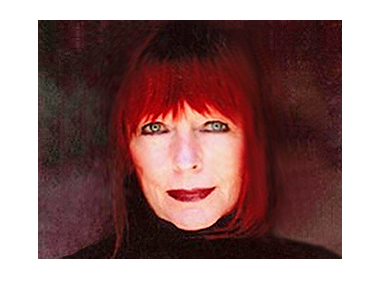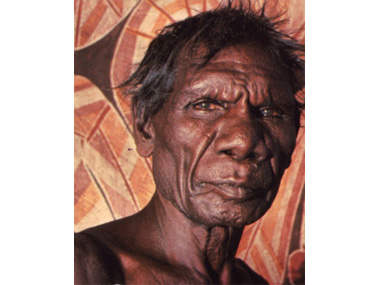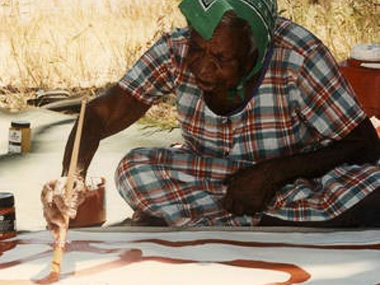The Shock of the Old

Frannie Hopkirk, new Feature writer at the AAD
Frannie Hopkirk | 17.02.14
Author: Frannie Hopkirk
Arabs believe that the soul can travel at the rate of a trotting camel.
From that one can imagine that the souls of millennia of aboriginal nomads, roving the desert, restless, ever-moving, searching, working, contemplating their existence, drawing their Dreaming into the sand or onto bark, dancing and singing, were and are, slowly but surely leaving their ‘soul’ tracks behind.
These soul tracks are the beginning and end of what Aboriginal art means. The eternal searching and finding of humanity on the move. The camel tracks of a race discovering and identifying itself and ‘place’. The unhurried sense of a culture developing through space and time, as a camel moves at a trotting pace, lends traditional Aboriginal art its stillness and ambiance. This art does not beg explanation – it just IS.
Robert Hughes’s book, The Shock of the New acquaints us with the cultural structures and stratagems of contemporary Western art. Conversely, the emergence from the desert and from deep past, of Aboriginal art, represents for us - The Shock of the Old.
This may rightly be called the greatest creative phenomena since the Renaissance. But low and behold, what has been hidden, like a secret, for centuries, has now unprecedented stature to international art collectors and dealers everywhere. But what is deservedly centre stage at last, remains unfathomable to many Europeans even now. What was, until recently, seen as quaint indigenous art: Namatjira post cards or prints of bark paintings, bought at airports with souvenir boomerangs, is now sold for big money and honored in the great art institutions of the world.
One of the biggest exhibitions of Aboriginal art ever seen was on display at the very heart of Western European art - the Pompidou Centre in Paris. This DEFINES mainstream – Aboriginal art has since then, been on the world stage.
Pulling my Encyclopedia of Australian Art from the shelves I found that exactly six pages had been devoted to Aboriginal art, less than a quarter of a page of text out of 382 pages. It states: “The transformation of ancient forms of Aboriginal art in the 20th century expression has been one of great success stories of contemporary Australian art.” There are have been many waterholes since that was written. The force and power of an art form we don’t fully understand, is sweeping all before it.
A subtle, visual intelligence is questioning our preconceptions and knowledge of art: our way of looking at art, how we understand or perceive it, how we make value judgments, critical assessments, philosophical insights and more. The foundations of Western comprehension and intellectual acceptance of art is being challenged.
Challenged because we have no template on which to judge. Just how do we define and understand Aboriginal art? Whereas there is little that one could call sacred in Western art, so much of what we see coming from Aboriginal outback communities, is based on sacred themes and stories, a visual language never intended for European eyes.
This is not modernism, it is not avant garde, it is not abstraction in the accepted sense. Art from the desert is not striving for financial success, or acceptance. It is not lying to you or trying to entertain you, in fact it doesn’t give a toss what you think of it. It doesn’t matter if critics pan it or people don’t buy it. It does matter if it is exploited, but that is another matter. Art traditions this old don’t need to worry about the future – because it is the past, the present and the future. It’s power is unassailable. This is God’s abstraction!
My brother Brett Whiteley had a great love of Yirawala. He considered this Aboriginal painter a master, a genius. That a Western painter like Brett could pronounce an old man from Kininjku (Western Arnhemland) a genius, is telling. Was Brett making a purely subjective value judgement? He adored Yirawala’s work, he recognized it as great art. But what does ‘genius’ mean in this context?
Yirawala exquisitely influenced Brett’s work. Through Yirawala he saw the beauty of the land, the delicacy and its drama. He saw the small underworkings and burrowing in landscape, the secret places of creatures, not seen on the surface. His painting, “Summer at Carcoar.” after Yirawala, illustrates this. The picture, which belongs to the Newcastle Regional Art Gallery, is a tribute to one of Australia’s great artists…Brett’s ‘genius’.
Genius is a power-word denoting hard work, energy, intelligence, talent – but its spiritual dimension is what holds it apart. When we respond to great beauty it is the sacred we are responding to.
Defining genius in terms of Aboriginal art is a whole new ball game – or the oldest game in the world. The old Masters of the desert – Emily Kngwarreye, Rover Thomas, Clifford Possum, Turkey Tolson Tjupurrula and many, many others are thrilling painters. Despite being unsure of what we are responding to we are responding. These pictures are secret codes, calligraphies of land, stories of ‘dreaming’, life and death, history and struggle known only to scholars, academics and the race of people from which it comes.
The image of Emily Kngwarreye, sitting or squatting on the desert floor, painting picture after picture, the numbers of which are mythical, virtually tossing them over her shoulder, as someone places another sheet of paper or canvas before her. The paintings she sheds like autumn leaves fluttering to the ground, are all jewels, many of them masterpieces. This is genius?
When we stand transfixed before a picture or a sculpture, something has kicked-in. Heart and mind are engaged. We are moved and excited. We experience profundity and mystery. It is strange and wonderful. This is a spiritual experience. These feelings for art or music or dance or poetry are subjective, very emotional. That is how it works if you are lucky. Walking into two big Aboriginal exhibitions at Newcastle Regional Gallery these things happened to me, in waves of pleasure, comprehension, revelation and gratitude.
References and Links
Artworks
Brett Whiteley, Summer at Carcoar (1977), Newcastle Art Gallery Collection
Brett Whiteley's tribute piece, To Yirrawalla (1972), Art Gallery of New South Wales Collection
Documentary
Emily in Japan - the Making of an Exhibition, by Andrew and Harriet Pike, Ronin Films (includes downloadable Study Guide)
Books:
Purchase Yirawala: Painter of the Dreaming by Sandra Le Brun Holmes at Amazon.com
Purchase Brett, A Portrait of Brett Whiteley by his Sister Frannie Hopkirk at Angus & Robertson Online or at Amazon.com
Share this:
»  del.icio.us
»
del.icio.us
»  Digg it
»
Digg it
»  reddit
»
reddit
»  Google
»
Google
»  StumbleUpon
»
StumbleUpon
»  Technorati
»
Technorati
»  Facebook
Facebook
Contact Details

The great artist, Yirawala, who Brett Whiteley regarded as a genius, and whose tribute, To Yirrawalla (1972) (see above) is held in a collection at the Art Gallery of NSW (photo courtesy "To Yirawala" by Sandra Le Brun Holmes, see above)

"Picture after picture...[Emily]...sheds like autumn leaves fluttering to the ground" (photo courtesy of Emily in Japan, a documentary by Andrew and Harriet Pike, featuring Margo Neale from the National Museum of Australia, details above)
Further Research
Artists: Albert Namatjira | Clifford Possum | Emily Kngwarreye | Rover Thomas | Turkey Tolson Tjupurrula
News Tags: Albert Namatjira | Andrew Pike | Art Gallery of New South Wales | Brett Whiteley | Clifford Possum | Emily Kngwarreye | Frannie Hopkirk | Harriet Pike | Margo Neale | Newcastle Regional Gallery | Rover Thomas | Sandra Le Brun Holmes | Summer at Carcoar | To Yirrawalla | Turkey Tolson Tjupurrula | Yirawala
News Archive
- 16.03.18 | SPECIAL REQUEST
- 05.03.18 | Competing National Aboriginal Art Galleries
- 20.02.18 | Gapu-Monuk – Saltwater Barks
- 15.02.18 | EMILY TRADUCED
- 06.02.18 | SONGLINES – TRACKING THE SEVEN SISTERS
- 31.01.18 | Dennis Nona Emerges in Hobart
- 26.01.18 | BAMBULA
- 21.01.18 | MY URRWAI
- 18.01.18 | Canada's First People First
- 15.01.18 | MISSION SONGS PROJECT
- 12.01.18 | SWEET COUNTRY
- 22.12.17 | The UN comes to Sydney Airport
- 21.12.17 | CHRISTMAS GOODIES
- 18.12.17 | TOMMY WATSON
- 14.12.17 | BARBARA AND THE CAMP DOGS
Advertising

